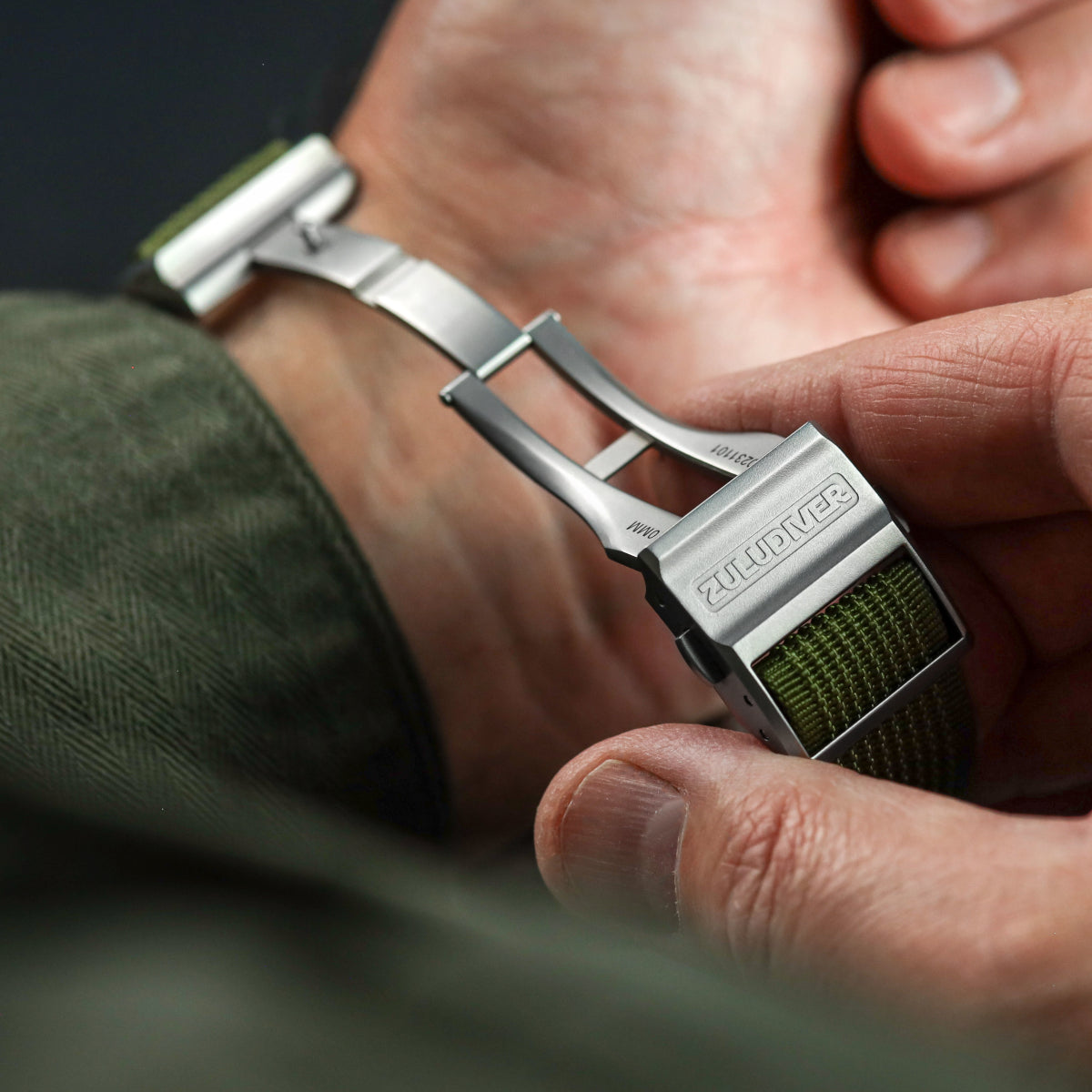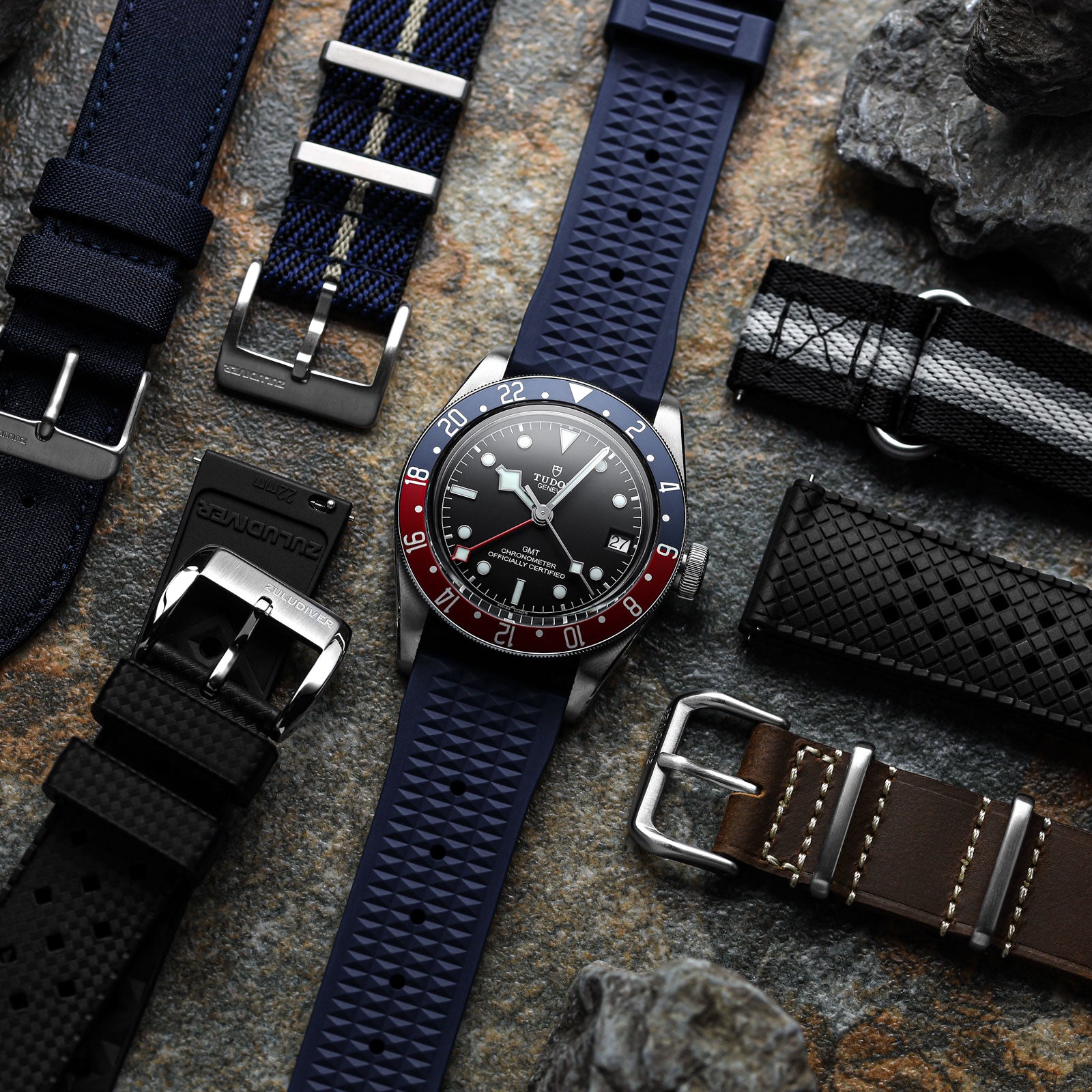Your Cart is Empty

How to change a watch strap

Categories
May 24, 2022
A helpful guide on how to change any kind of watch strap.
Lug Width
Measuring the lug width of a watch is an important step in determining the size of replacement straps or bands. The lug width is the distance between the two points on the watch case where the strap or band is attached. Here are the steps to measure the lug width of your watch:
- Use a steel ruler or, preferably, a set of calipers (vernier) for accurate measurements. Identify the two lugs on the watch case. Measure the distance between the inside of one lug to the inside of the other lug. Ensure your measurement is taken from the inner edges for precise results.
- Measure in millimeters (mm) as most watch straps and bands are measured in millimeters.
- If you're unsure of the lug width of your watch or can't find it on the watch itself, you can also check the manufacturer's website for the specifications or contact them for assistance.
- It's always worth checking the inside of the watch strap you are replacing, as the lug width may be marked there. This will make it easy to find a replacement strap that fits your watch perfectly.
Get the right tools
When changing watch straps it's best to have a spring bar tool handy. We recommend the Professional Spring Bar Tool, for both value for money and excellent quality. A benefit of this spring bar tool is its versatility. One end of the tool holds a wider fork for leather watch straps and a thinner fork on the other end for metal bracelets. You can switch out the thinner fork end with a flat-ended pin, ideal for attaching the bracelet back onto the watch.
Preparation area
When changing your strap it’s best to do so on a flat surface, laying your watch on a cloth or other soft surface which will help keep your watch still and prevent the crystal from getting scratched. For added protection against scratches, consider taping the watch lugs with masking tape.
Removing the current strap
Watches with quick-release straps
Many modern straps and bracelets come with quick-release straps. This makes removing easy and tool-free, with no risk of it flying across the room. Simply squeeze the protruding part of the bar inwards until the strap releases. You may also need to apply light pressure to the strap if it doesn’t detach immediately.
Watches with drilled lugs
Some watches have drilled lugs, which makes removing straps a lot easier. For these watches simply insert the rounded pin of your spring bar tool into the drilled hole making sure it’s in properly. Then gently push the tool to release the spring bar. You may have to wiggle the strap a little at the same time. Set the spring bar aside somewhere safe for later.
Removing a bracelet
On bracelets, you’ll see that the end links of the bracelet (where it attaches to the watch head) will have cut-away slots allowing you to partially see the spring bar.
Use the v-shaped/forked end of your spring bar tool and slot it in at the outside edge of the slot. If the spring bar tool you have has two different forked ends, use the smaller, thinner end for removing a bracelet. Then, slowly slide the tool inwards until you feel the shoulders/flange.
Then, gently pry the spring bar out by pulling it towards the centre of the watch until you hear/feel it release. Depending on the bracelet you may need to apply some pressure to the underside of the bracelet to get it to release.
Occasionally you may also encounter a stubborn bracelet and the spring bar may only partially release. If that’s the case, you will need to use the tool to release the spring bar on the opposite side also.
Removing a leather or rubber strap
Lay the watch face down, then carefully position the v-shaped end of the spring bar tool so that it slots between the end of the strap and the inside of the lug. Applying light pressure against the spring bar, gently pry the spring bar out by pulling it towards the centre of the watch until you hear/feel it release.
Fitting a new watch strap
Fitting a quick-release strap
Simply position one end into the lug hole. Once secure, position the other side of the spring bar so that it roughly sits over the lug and then squeeze the bar inwards whilst positioning the strap until you feel/hear the spring bar snap into place. Give the strap a light tug to make sure it's secure.
Fitting a regular watch strap
Place one end of the spring bar fully into one of the lug holes. Once in place, position the other side of the spring bar so that it roughly sits over the lug.
Using the spring bar tool, compress the spring bar whilst lowering the end into place, aiming for the lug hole. Getting the second end of the spring bar into place is not always easy, so you may have to carefully move the strap around within the confines of the lug until you feel the spring bar locate and snap into place. Give the strap a tight tug to ensure they’re secure.
When fitting a watch strap, make sure the buckle end is attached on the 12 o’clock side of the watch and the tail-end at 6 o’clock. For bracelets with a fold-over clasp, ensure that the section of strap with the visible part of the clasp (often with the brand’s logo on) is fitted to the 12 o’clock side of the watch.
How to fit a Military style watch strap
Place your strap and watch on a flat surface, ensure the buckle end of the strap is placed down on the left. Also ensure the watch displays the 12 o'clock position on the left (nearest to the buckle).
Thread the non-buckle end of the strap underneath the left lug gap, then pass the strap end through the right lug gap. Pull the strap end tight.
Position the watch so that it is between the buckle on the left and loops on the right. Pass the non-buckle end of the strap through the remaining loops on the right.
Your watch is now securely fastened to your Military Nylon strap, however, do a final check and ensure all loops are threaded through correctly and the watch displays 12 o'clock position at the top.

Useful tools for changing watch straps.

About the Author: Andy Hillier
About the Author: Andy Hillier
As the head of brand development at ZULUDIVER, I believe that a strong brand is not just about creating a logo or a tagline, but about telling a compelling story that resonates with our customers. We want to create a brand that not only sells products, but also inspires and connects with people on a deeper level.
More Articles by Andy Hillier




